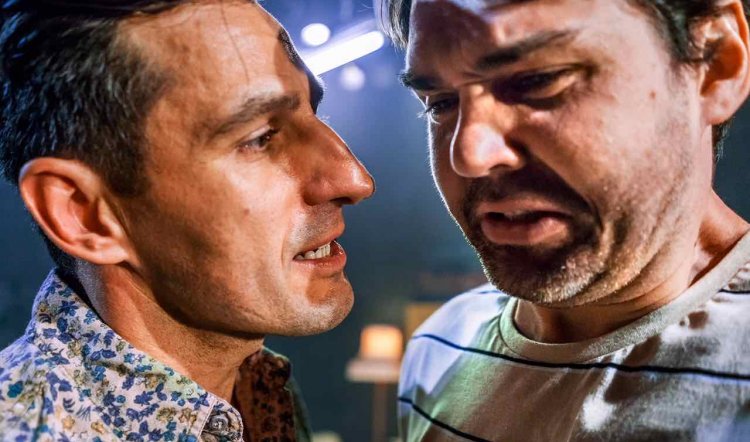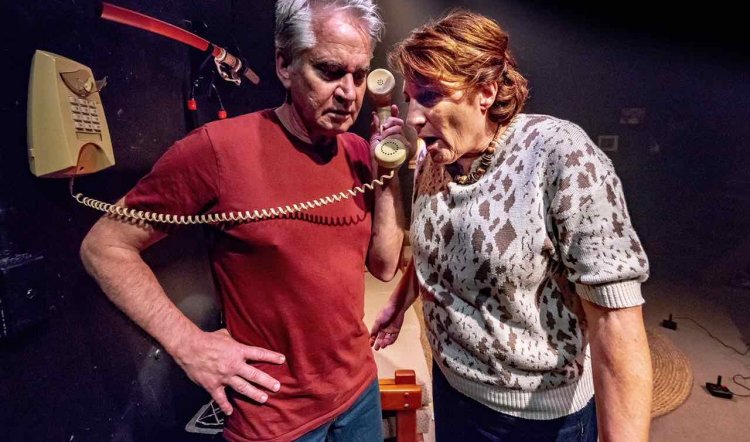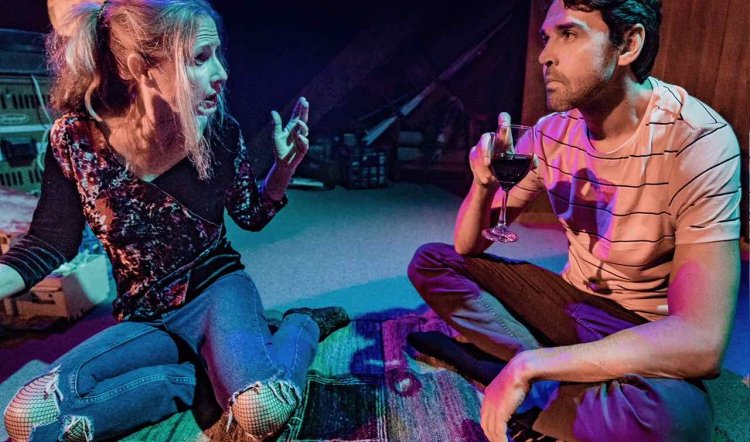
STALKING THE BOGEYMAN
STALKING THE BOGEYMAN, Redline Productions at the Old Fitz, 23 May-23 June 2018. Photography by John Marmaras: above Radek Jonak and Graeme McRae; below - Noel Hodda and Deborah Jones; below again - Anne Tenney and Mcrae
The old saying that “truth is stranger than fiction” is writ large in Stalking The Bogeyman, by American reporter David Holthouse in collaboration with playwright Markus Potter. Holthouse initially stunned readers of independent news site Denver Westword in May 2004 with, “Stalking the Bogeyman: Coming to grips with the killer inside me”.
That subtitle is crucial to Holthouse’s story, described as a first-hand account of how he was assaulted and raped, aged seven, by a teenager (Radek Jonak). It had happened in the older boy’s basement den-room while upstairs his parents (Anne Tenney and Alexander Palacio) were being neighbourly and making welcome over a few hands of cribbage David’s parents (Noel Hodda and Deborah Jones), newcomers to Anchorage, Alaska.
The play opens, in a setting of comfortable suburban normalcy (design Lauren Peters, lighting Alexander Berlage simultaneously portraying suburban Denver and Anchorage) with the adult David (Graeme McRae) telling the audience, “This time last year, I had a gun, and a silencer, and a plan.” Throughout the concise yet surprisingly leisurely telling, McRae alternately portrays the kid and the man while we go with him through the process of acquiring the weapon illicitly from a low-rent crim (also Palacio) as well as vivid incidents of being bullied and taunted by the teenager.
At the same time, the four parents are upstairs – same space but clearly delineated through Neil Gooding’s subtle, sensitive direction – and are innocently doing what unremarkable parents do to be sociable and polite: a few drinks, a bit of banter, nothing too demanding or interesting. The contrasts are stark and shocking, not least because aside from some verbally vicious teasing and play-threatening of the hapless David with bits of martial arts armaments, the assault and rape are left to our imagination: the most powerful weapon of all.
That weapon is also used with devastating effect against the child David when his attacker threatens him with the unimaginable if he ever tells. For a child, of course, the unimaginable is often something like, “your parents will hate you”, or “your parents won’t believe you and they’ll send you away”. Many kids experience these ideas, to devastating effect. And so we learn David says nothing to anyone despite physical and psychic pain that accompany him into adulthood.
It’s no surprise to also learn that as a journalist, he’s followed the Gonzo path – made infamous by Hunter S Thompson and characterised by off-the-wall and over-the-top story-telling, in a style Wikipedia handily summarises as, “written without claims of objectivity, often including the reporter as part of the story via a first-person narrative...”

Also not surprising to learn that David’s childhood scars are scraped raw and bleeding once again when he discovers his childhood tormentor has moved from Alaska to Denver, with his wife and kid. In reality, at that point, the journalist didn’t simply write, “This time last year I had a gun, and a silencer, and a plan.” In its entirety, Holthouse’s opening paragraph was not only Gonzo but also, would give an audience a quite different attitude towards the man:
“I was going to watch him writhe like a poisoned cockroach for a few seconds, then kick him onto his stomach and put three bullets in the back of his head. This time last year I had a gun, and a silencer, and a plan.”
Oh, the wonders of editing, the wonders of audience manipulation, the wonders of playwriting! Suddenly David is another person, drawn in different colours and with subtexts and undercurrents that bubble up into uneasiness. Is this really a truth that’s stranger than fiction, or a strange set of truths, or a mix of truth and fiction, or..?
What we learn, from the play’s opening moments, is that the boy David and his parents lived in a house once occupied by a family that left Anchorage after their young son started “acting up” at school... We also learn, along the way, that the Bogeyman/rapist/present day normal family man has met with David in a Denver park and promised him their long-ago encounter had been a one-off. He had not done such things before or since. He asks for forgiveness. However...
Criminal and medical statistics suggest it’s unlikely that David was the teenager’s only victim. The play’s opening plainly says otherwise. And given his gleeful description to David of other heinous acts involving small animals and fireworks, it’s obvious that the boy was deeply disturbed and heavily into behaviours that couldn’t possibly Just. Stop. Why would a successful news journalist believe him? Why would he not already know – given his own history – that his attacker is most likely lying? Why are there so many questions in this fascinating, troubling story left unanswered and not adding up?
Those thoughts aside, there’s another weird twist that doesn’t make it into the play: a friend of David’s, one Manuel Guanipa, was arrested two months after the story was published on suspicion of stalking the Bogeyman and his wife. And David was arrested on a felony stalking charge the next day when he went to post bail for his friend.

On July 1, 2004, local TV affiliate The Denver Channel reported the Assistant DA announcing he had, “decided not to pursue charges against writer David Holthouse, 33, and his friend, Nelson Guanipa, 29, after the couple they were accused of stalking indicated that they do not want stalking charges to be filed.”
As that wise old storyteller Sir Walter Scott once wrote, “O, what a tangled web we weave when first we practise to deceive...” And Stalking The Bogeyman is an amazing, enthralling mix that may or may not contain nuts, fabulism, reportage, tragedy and the kind of literary imagination not seen since The Hand That Signed The Paper.
Punctuated by sound design and composition from Benjamin Freeman that add a further layer of tension and authenticity to a production already steeped in both, Neil Gooding and his cast have achieved a brilliantly entertaining 75 minutes of drama. Whether or not it’s true or Gonzo-true, whether or not there’s more to this story than we yet, or will ever know, this staging of Stalking The Bogeyman is one of the best short, sharp, shocking evenings you could hope to spend in a theatre.
1800Respect.org.au or 1800 737 732 if you or someone you know are being or have been affected by sexual assault, domestic or family violence.



